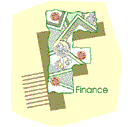In an efficient securities market, prices of securities, such as stocks, always fully reflect all publicly available information. This raises the question “What should the price be?”
 The well-known Sharpe-Lintner capital asset pricing model (CAPM) provides an answer. According to the model a share’s current market price will be such that:
The well-known Sharpe-Lintner capital asset pricing model (CAPM) provides an answer. According to the model a share’s current market price will be such that:
Expected return on the share E(Rjt) = a constant Rt(1 – βj) + expected return on market portfolio E(Rмt) x beta of the share βj
Using CAPM Formula Equation
An example of the model:
Assume the following:
Risk-free return = 6%
Expected market return = 12%
Beta of firm j = 0.8
Dividend of firm j = $ 1.00
Share price at the beginning of the period = $ 20.00
Find the share price at the end of the period for the given expected value.
First, calculate the expected return on the firm’s shares from CAPM:
Expected return = Risk-free rate (1 – Beta) + Beta (Expected market rate of return)
= 0.06 (1 – 0.8) + 0.8(0.12)
= 0.012 + 0.096
= 10.8 %
Then, calculate the ending price that supports an 10.8 % expected return.
For calculating the ending price, apply the net rate of return formula as under:
Expected return = [(Expected ending price + Expected dividend) / Beginning price] – 1
0.108 = [P(end) +1.00/20.00] – 1
1.108 = [P(end) +1.00]/20.00
20.00 x 1.108 = P(end) + 1.00
22.16 = P(end) + 1.00
22.16 – 1 = P(end)
P(end) = $ 21.16
If bad earnings news about the firm arrives in the market at the beginning of the year resulting in the expected return on the firm’s shares falling from 10.8 % to 10%, this would only support an ending price of $ 21.00 calculated as under by applying the net rate of return formula:
0.10 = [P(end) + 1.00/20.00] – 1
1.10 = [P(end) + 1.00]/20.00
20 x 1.10 = P(end) + 1.00
22.00 – 1.00 = P(end)
P(end) = $ 21.00
One of the variables has to change to keep the expected at 10.8% It is important to note that the factors that make up the CAPM are independent of earnings news. The fixed rate would come from treasury bills or government bonds. Beta is assumed as constant and the expected return on the market portfolio is independent of the firm, and so does not change. The only variable where change is possible is the beginning share price. What should it fall to?
0.108 = [(21.00 + 1.00/P(beg.)] – 1
0.108 + 1 = 21.00 +1.00/P(beg.)
1.108 = 21.00 + 1.00/P(beg.)
P(beg.) = 22.00/1.108
P(beg) = $ 19.86
To maintain the 10.8% expected return, the share price will have to fall to $ 19.86, and the share price at the end of the year would be $21.00
Verification: [$ 21.00 (price at the end of the year) + $ 1.00 (expected dividend) –
$ 19.86(price at the beginning of the year]/ $ 19.86
= 2.14/19.86 x 100
= 10.8 % (expected return)